A Wobbly Structure and Big Windows Lead to Big Leaks
Let us start with an excellent article on OEM installed leaks by Marinesurvey.com.
Note how OEM "sins" such as large acrylic windows pressed into relatively unsupported fiberglass is exactly what you will find in all Prout Escales. Some of the roof sections are inadequately supported and the inevitable flexing that the lack of strength follows will always lead to leaks as the seals are worked.
While Prout Catamarans wrote to us in 1992 that they would replace the broken windows (at the time they had possession of the boat during the winter), this never happened.
The windows themselves seem to be part of the load bearing structure. In my opinion, this is a no-no because it indicates that the rest of the structure is weak. Remember, Prout Catamarans builds cruising multihulls, not racing sleds. Durability and redundancy requirements differ accordingly. To have a hull structure that flexes enough to make something as tough as acrylic snap (before UV has weakened it) speaks volumes about the stresses that the windows encountered.
So what do you do when you're halfway across the Pacific and the two front windows go because the storm you're in makes the boat flex? Call Canvey Island? Furthermore, even IF Prout Catamarans agrees to replace the acrylic windows, they are only treating the symptom, not the problem (the hull flexing). Ergo, in the future, you will have the same problem all over again unless your cruiser becomes a house boat in a marina.
We also discovered several joints inside the boat where the fiberglass had started to come undone. The largest breach was around a front corner of the port water tank, where a whole section of skin had lifted off. A letter of inquiry to Prout suggested a epoxy patch, but no consternation or an offer to fix it for us. I suppose it's normal for structural joints to come undone?
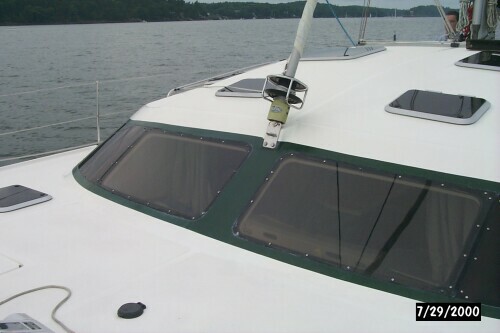
On the foredeck, looking to starboard past 2 saloon windows and the wrap-around window of the starboard cabin. Note the location of the second jib.
The large windows are certainly impressive, but there is a large cabin roof to be supported. Much of the load rests on the internal bulkheads that criss-cross the boat. While Prout claims to have beefed them up in recent years, our boat still features the relatively thin sections of yesteryear.
Particularly problematic is the large saloon area. The two large windows facing forward are bedded to a very thin section of skin that makes up the deck in the saloon area. The second jib attaches to that already thin section of fiberglass on top of the two saloon windows (albeit reinforced with some wood).
In more recent boats, Prout has moved the second jib point to the somewhat thicker forward deck. But the fiberglass in our deck just forward of the saloon windows is very weak, as it easily deflects whenever the windows are not present to act as a reinforcement.
The lack of support under the deck lead immediately to a stress crack in the gel coat. This crack is centered around the center of the boat, just forward of the windows where the deck structure is at its thinnest. One benefit of the doubt we can give Prout is that they wanted to keep the weight down and consequently did not extend the balsa core throughout the front deck.
Another possible explanation is the desire to increase head room underneath the front deck as much as possible. Either option is far too altruistic - it is far more likely that Prout simply did not want to spend the time and money to build the front deck right.
Acrylic and Lexan side-by-side. The Lexan is a lighter shade.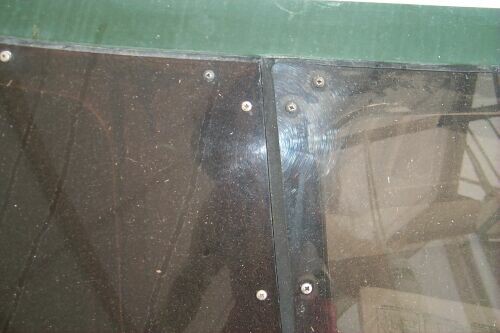
Windows should not be part of the load bearing structure, as the flexing will induce leaks over time. Particularly in the first three years, the boat was so flexible that joints would open and close ¼" throughout the cabinetry. Many of the tiny screw holes in the fiberglass under the window became enlarged, while the windows cracked.
Eventually, Prout was embarrassed into stiffening the boat with reinforcement beams to lessen the joint action. And while Prout gave us a written assurance that they would replace the faulty windows, they never elected to do so. We replaced the cracked acrylic with Lexan, a much more durable material. These windows are now bedded in polysulfide. They probably don't need fasteners anymore as the chemical bond is incredibly strong. We have yet to reinforce the fiberglass but intend to make it much stiffer. The Kevlar felt I bought for the dinghy bottom should do nicely.
Our biggest concern is how to create a strong bond between the old and the new layers of fiberglass . According to WEST System, the best we can hope for is a strong secondary bond. Thus, we will build a self-supporting structure with a large surface area to take advantage of as much of the load as possible. Re-upholstering the inside of the boat will be a long project afterwards but the hull will then be strong enough to support movement on the foredeck, roof, etc. and wave loads without self-destruction.
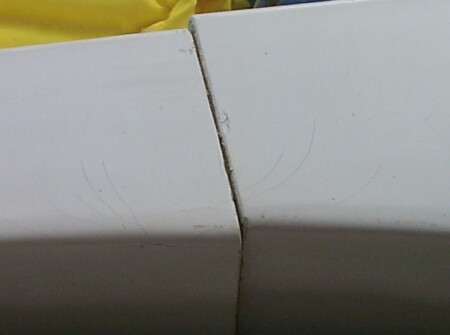
The flexing due to the companionway configuration also took its toll on other parts of the boat. Doors would not open or close under way, and one opening cannot be budged to this day: The tiltable backrest in the saloon area (for access to the "playpen"/ bed in front of the saloon - this is a family layout) is frozen in place. More worrisome are the plethora of stress cracks in the gel coat of the fiberglass that makes up the backrest and saloon couch. We are currently considering our options and may install a beam across the backrest to give the boat more stiffness.
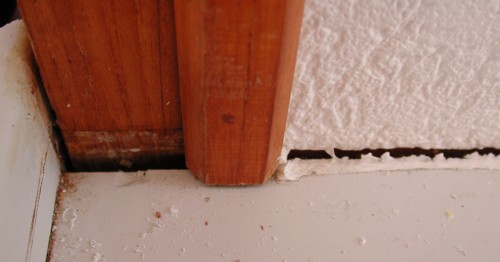
However, there are other issues we'll have to address as well such as the delamination between the saloon section and the surrounding bulkheads. This seam is almost ¼" wide and runs for over a foot between the forward head and the backrest in the saloon area. We're currently studying how to best tab the various interior sections to each other in order to maximize rigidity.
A similar joint has opened between the kitchen counter and the adjoining wall. Perhaps two years out of the water bent the boat? Not likely given that the cradle is true, offers a large surface to rest on for the keel, etc. but a possibility nonetheless. Elsewhere, the leaks continued. The nect window to leak significantly was wrapped around the forward bathroom.
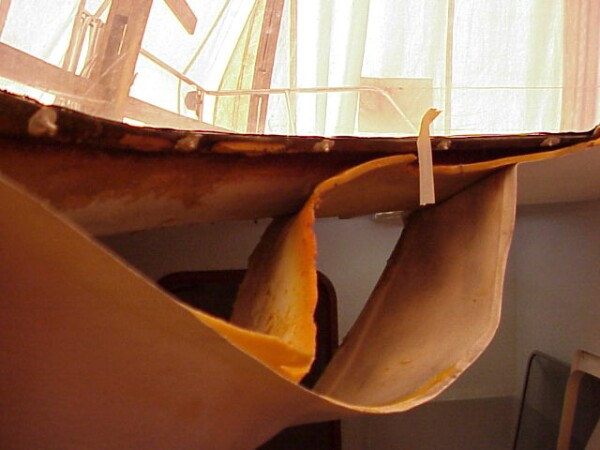
Here is the mess we are now starting to deal with in the bathroom. Note the decomposition of the foam backing (heat from the windows darkened it) as well as the Prout tradition of painting fasteners upon installation.
What is so curious to me is the manner in which the fiberglass deck thickness is thinned considerably where the windows are installed. The integral frame is solid (good given the considerable water ingress) but so thin that I consider it somewhat suspect. The way in which the screw holes have been chewed out attests to the considerable flexing during the life of the boat.
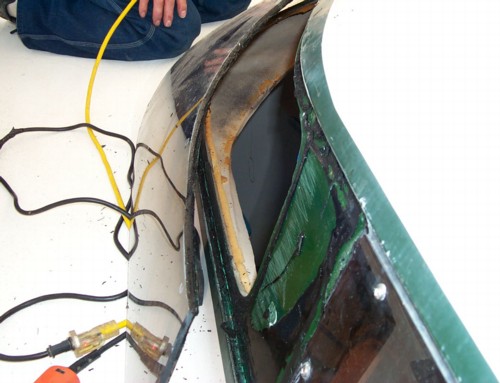
Removing the acrylic wrap-arounds is trickier than the nearly flat saloon windows. The acrylic weakens significantly with time and the window is quite fragile. Note the thin bead of sealant used - very little stood between us and the water outside. I had consulted the internet for replacement sealers, as polysulfide would have the acrylic windows for breakfast. Several sources liked GE Silpruf, so I bought a number of tubes.
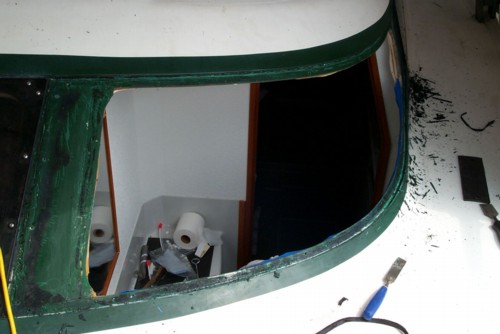
After cleaning off the little sealant there was, we could get to work.
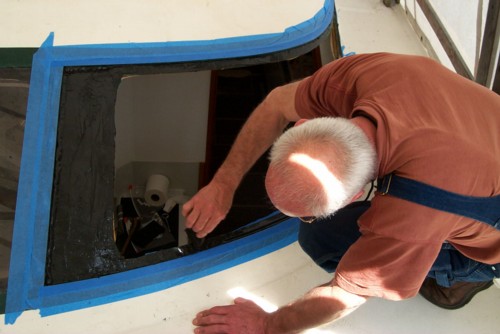
Here, Gerald is applying the GE Silpruf on the window frame in anticipation of putting the window back.
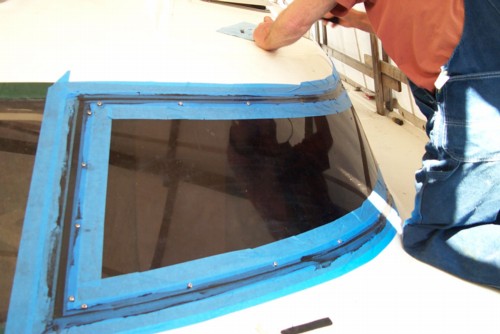
With the window pane back in place, we could go about smoothing the Silpruf to a flat surface.
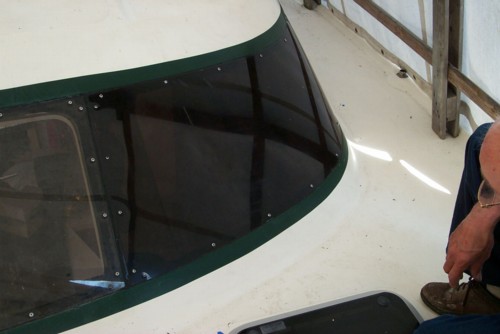
The finished product looked great but leaked like a sieve. For some strange reason, the Silpruf never hardened and kept the consistency of pudding. Thus, we had to repeat the process. The second time, we used Sikaflex 295, which worked great.
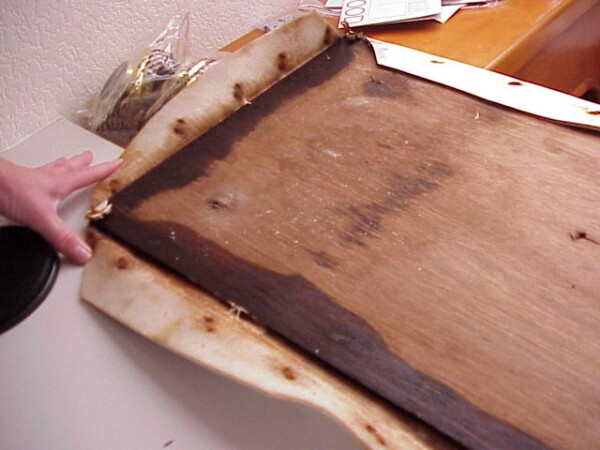
Here is a panel from the bathroom attesting to the repeated water ingress. We'll apply the same repair strategy as with the saloon headliner and hopefully never see this panel again.
Best Estimate of Time Required:
| Attempts to seal acrylic saloon windows despite cracks | 2 hours |
|---|---|
| Later removal of acrylic saloon windows, all traces of sealant | 24 hours |
| Purchase, cutting, installation of new saloon windows | 8 hours |
| Removal/Reinstallation of bathroom acrylic window & re-bedw/better sealant | 24 hours |
| Removal/Reinstallation of other acrylic windows | TBD |
| Fix undone fiberglass in bilge | 0.5 hours |
| Total | 58.5 hours |
|---|


